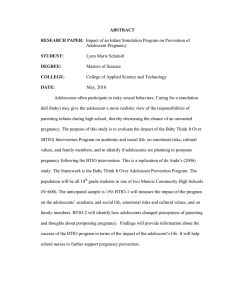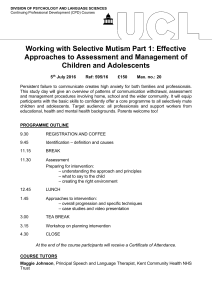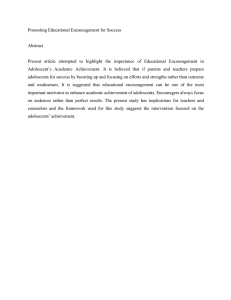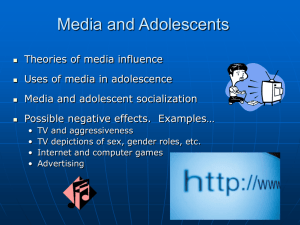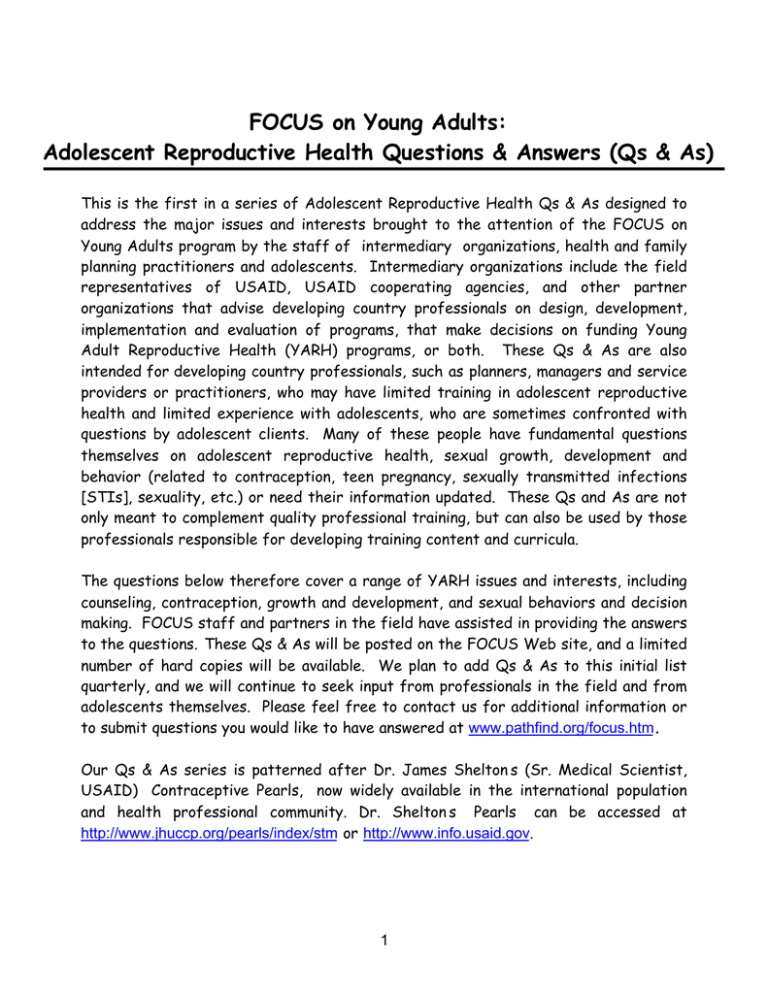
FOCUS on Young Adults:
Adolescent Reproductive Health Questions & Answers (Qs & As)
This is the first in a series of Adolescent Reproductive Health Qs & As designed to
address the major issues and interests brought to the attention of the FOCUS on
Young Adults program by the staff of “intermediary” organizations, health and family
planning practitioners and adolescents. Intermediary organizations include the field
representatives of USAID, USAID cooperating agencies, and other partner
organizations that advise developing country professionals on design, development,
implementation and evaluation of programs, that make decisions on funding Young
Adult Reproductive Health (YARH) programs, or both. These Qs & As are also
intended for developing country professionals, such as planners, managers and service
providers or practitioners, who may have limited training in adolescent reproductive
health and limited experience with adolescents, who are sometimes confronted with
questions by adolescent clients. Many of these people have fundamental questions
themselves on adolescent reproductive health, sexual growth, development and
behavior (related to contraception, teen pregnancy, sexually transmitted infections
[STIs], sexuality, etc.) or need their information updated. These Qs and As are not
only meant to complement quality professional training, but can also be used by those
professionals responsible for developing training content and curricula.
The questions below therefore cover a range of YARH issues and interests, including
counseling, contraception, growth and development, and sexual behaviors and decision
making. FOCUS staff and partners in the field have assisted in providing the answers
to the questions. These Qs & As will be posted on the FOCUS Web site, and a limited
number of hard copies will be available. We plan to add Qs & As to this initial list
quarterly, and we will continue to seek input from professionals in the field and from
adolescents themselves. Please feel free to contact us for additional information or
to submit questions you would like to have answered at www.pathfind.org/focus.htm.
Our Qs & As series is patterned after Dr. James Shelton’s (Sr. Medical Scientist,
USAID) “Contraceptive Pearls,” now widely available in the international population
and health professional community. Dr. Shelton’s “Pearls” can be accessed at
http://www.jhuccp.org/pearls/index/stm or http://www.info.usaid.gov.
1
Counseling
Q.
What are the best strategies for counseling adolescents about delaying sexual intercourse?
A.
•
•
•
•
•
•
•
•
Q.
When counseling adolescents, the following strategies should be taken into
consideration:
Recognize for themselves as providers, and share with the adolescent client, that
sexual interest and desire during adolescence is normal and natural.
Explore with the client the client’s personal values and those of his or her family
regarding sexual activity, taking into account his or her age, gender, marital status,
social norms and expectations.
Encourage the adolescent to have discussions with family or significant others in his
or her life, if appropriate.
Ask the adolescent to discuss how far he or she is willing to go with respect to
intimate sexual contact with his or her partner.
Ask the adolescent to identify the pros and cons of becoming sexually active
(including health and social risks) and the potential effect of sexual activity in
general, and sexual intercourse in particular on themselves, their partners, their
family, and others.
Discuss and provide information on “how to say no” to unwanted or unprotected
sexual activity. Suggest and explore possible responses to pressure from partners
and peers. One way to do this might be through role-playing “real life” situations so
that the adolescent develops the language and skills needed to negotiate with a
partner or peers.
Help the adolescent set realistic life goals, and discuss how an unplanned pregnancy
might disrupt the accomplishment of those goals.
Provide complete information about preventing pregnancy and STIs, including AIDS,
and information about where to obtain additional information and services, should
the adolescent choose to become sexually active.
What needs to be known about the physical and psychosocial development of young clients to
more effectively reach, serve and counsel them?
A. It is important to know the following facts about adolescent development:
Physical Development
• Providers need to understand puberty and the accompanying body changes
experienced by both boys and girls.
2
•
•
Girls begin menstruating and boys reach puberty at earlier ages than in previous
decades. That, in many cases, means an increase in the time between the onset of
puberty and marriage and a greater period of possible sexual activity and risk for
pregnancy and STIs.
Among younger female adolescents, the lack of physical maturity may put them at
greater risk for complications during pregnancy.
Psychosocial Development
• Adolescents are very concerned about being “normal,” and they may have a great
deal of anxiety about the changes their bodies are going through.
• Adolescents respond to and integrate information differently on the basis of age,
stage of development and level of maturity. For example, many adolescents may
have difficulty grasping complex concepts or complicated medical terms, so
information needs to be repeated several times or explained in different ways, using
simple language and a variety of media.
• Adolescents may be at greater risk of STIs, including HIV, because of an inability
to negotiate within relationships that are often with older adolescents or with
adults.
• Lifestyles of many adolescents may not be conducive to the kind of routine or
privacy necessary for consistent contraceptive use. Therefore, consideration needs
to be given to the method that best fits the individual's lifestyle, or the provider
needs to work with the adolescent to figure out how best to accommodate the
method within his or her lifestyle.
• Many adolescents have engaged or are currently engaging in sex against their will,
have been or are being abused, or are coerced into having sex in return for favors
such as payment of school fees.
• Not all adolescent sexual relationships are heterosexual.
• To the extent possible, providers need to engage adolescents in discussions that
help assess:
0 whether the adolescent is engaged or has engaged in sex for any of the reasons
noted above;
0 his or her level of knowledge about preventing pregnancy and STIs and his or her
perception of risk;
0 whether the adolescent practices safe sex every time;
0 if the adolescent has had multiple partners;
0 if the adolescent has engaged in same-sex sexual relationships; and
0 if the partner or partners of the adolescent is engaging or has engaged in samesex sexual relationships.
• Adolescents may not be forthcoming with information, particularly about their
sexual experiences, and it may take extra effort to establish a relationship
conducive to getting the necessary information from them.
• Adolescents may face pressure from partners and/or peers to have sex.
3
Q. How is counseling young people different from counseling adults?
A. Counseling young people is different from counseling adults in the following ways:
•
•
•
•
•
•
•
Youth may be less informed about their bodies, reproductive capacity, contraceptive
methods, their risk for pregnancy and STIs and HIV/AIDS, and these issues may
have to be brought up by the counselor.
Adolescents may also have dangerous misconceptions or false beliefs because of
inadequate or poor sources of information.
Many societies tend to be less accepting and less tolerant of sexual activity among
adolescents in general and those who are unmarried in particular. As a result, it may
be more difficult for adolescents to admit to being sexually active and share
important information, particularly if they perceive bias on the part of the provider.
Adolescents may seek or accept greater guidance from a professional whom they
hold in high regard.
Adolescents are less likely to be in stable relationships.
Adolescents generally require more counseling time to ensure that they understand
information and instructions and have an opportunity to address other issues they
may bring to the counseling setting.
Adolescents may present a wider range of concerns-such as those related to their
relationships with partners, peers and family members-as opposed to purely medical
concerns or those related to contraception. They may also have questions or may
need assistance with issues related to relationships with family members, school and
employment. As a result, the counselor should be aware of available resources and
be able to refer the adolescent.
Q. What are the most important points to cover when counseling adolescents about sexual
behavior?
A. When counseling adolescents about sexual behavior, it is important to:
•
•
•
•
•
•
•
Help them understand the physical and emotional changes that occur with growth
and development.
Stress the importance of clarifying one’s personal values and having skills to ensure
that unwanted sex does not occur.
Dispel local and customary myths and practices that may be harmful or put the
adolescent at greater risk for pregnancy or STIs.
Ask questions that help assess risk, including STIs and possibly abusive
relationships.
Ensure that an adolescent understands his or her own risk for contracting, and how
to protect against, STI/HIV infection and unplanned pregnancy.
Stress the importance of communication and mutual respect in sexual relationships.
Inform them of the location of other “youth-friendly” services and resources.
4
Fertility
Q. Does
long-term use of contraceptives by adolescents affect future fertility?
A.
No. In fact, contraception can have an important protective effect on future
fertility by preventing unsafe abortions. An unsafe abortion frequently causes infection
that can lead to infertility. The other major threat to an adolescent’s future fertility
is from STI's, particularly chlamydia (which is difficult to diagnose and often has no
symptoms), gonorrhea, and pelvic inflammatory disease (which is an acute infection in
the fallopian tubes as well as other organs in the pelvic cavity). The fact that many
adolescents do not seek services until STIs are in advanced stages, if at all, further
compounds the problem.
• Barrier methods and condoms have no direct effect on future fertility except that
condoms and perhaps spermicides contribute to preserving fertility by preventing
STIs.
• Long-term use of oral or injectable contraceptives does not affect future fertility.
After stopping birth control pills, fertility returns almost immediately to most
young women. After stopping the injectable DMPA (Depo-Provera), there is an
average 3-month delay partly because of some residual hormone remaining in the
system.
• IUDs also have no effect on future fertility if the client does not have or does not
contract an STI. However, it should be noted that IUDs are typically not used with
adolescents who have no children, because insertion is more painful and
complications more frequent. Adolescents may be at higher risk for contracting an
STI, and the consequences of contracting an STI may be higher.
• Long-term use of Norplant has no effect on future fertility.
Q.
Does long-term use of contraceptives have any positive or negative health effects on
adolescents?
A.
•
•
•
Oral contraceptives and injectables can help preserve the fertility of young women.
Contraceptive pills also reduce the risk of benign cysts in the breast.
Both oral and injectable contraceptives can help protect women from pelvic
inflammatory disease (PID), an infection that damages the fallopian tubes and can
cause infertility or an ectopic pregnancy.
Use of contraceptives may reduce the risk of ovarian and endometrial cancer, may
protect against ectopic pregnancies, may prevent iron-deficiency anemia, and may
reduce acne and menstrual cramps. Use of pills and injectables appear also to have
most of these benefits.
5
•
•
•
Q.
Copper IUDs result in lower risk of ectopic pregnancy compared with using no
method.
There is the potential for infection with an IUD in the first 21 days after insertion
if exposed to STIs.
There are no negative effects of long-term use of Norplant.
What is the importance of nutrition for young girls who have not yet given birth?
A.
•
•
In many developing countries, girls suffer forms of discrimination that put them at
nutritional risk, including discrimination in food allocation (boys and men receive
more), less medical care than boys, a heavy work load from a very early age, and
food taboos, particularly during menstruation and pregnancy. Nutrition is very
important during adolescence because it is a time of rapid growth in height, weight
and body fat (50% of adult weight is achieved in the two or three years around the
pubertal growth spurt).
In girls, the growth rate is especially rapid in the year preceding menarche, usually
between the ages of 10 and 13. If a girl does not get adequate nutrition during this
time, menarche may be delayed, and she can suffer growth retardation and be more
prone to disease.
6
Contraception
Q. What
contraceptive methods are medically safe and/or appropriate for adolescents?
A.
There are no medical reasons based on age alone to restrict contraceptive method
choices. However, which method is most appropriate may be influenced by the personal
preference and social context, including the risk of STIs, HIV/AIDS, stability of the
relationship, and marital status.
Q.
Should there be any age requirements or restrictions for certain methods on the basis of
medical criteria?
A.
•
•
•
Q.
No.
There are no medical reasons on the basis of age to restrict contraceptive method
choices for young women at risk of pregnancy. However, Depo-Provera (DMPA) is
permitted but less preferred before age 16 because of possible negative effects on
bone density. Theoretical concern exists that adolescents under the age of 16 years
who use DMPA may have an increased risk of developing osteoporosis later in life.
Early adolescence is an important time for bone formation, as peak bone density
normally is reached in women at about age 16. Use of DMPA before the age of 16
could result in lower peak bone density. World Health Organization (WHO) medical
eligibility criteria consider DMPA to be generally acceptable for women aged 16 or
younger, because the benefits of using the method (i.e., avoidance of unwanted
pregnancy) outweigh the theoretical risk. There are no restrictions for the use of
DMPA after age 16.
The one-month combined injectable will not have any effect on bone density.
IUDs are less preferred because of the risk of STIs and greater side effects,
including higher expulsion rates, particularly for women who have never been
pregnant.
Can any type of oral contraceptive be used for emergency contraception?
A.
No.
Only the progestin only formulations or those combined oral contraceptives that contain
the progestin levonorgestrel or norgestrel have been shown to be effective for
emergency contraceptive use. Pills containing other progestins may be effective, but
they have not been studied. Either low-dose pills containing 30 mcg of estrogen or
higher-dose pills with 50 mcg of estrogen may be used. In some places, emergency
contraceptive pills have been packaged specifically for that use. A total of 8 low-dose
7
pills or 4 higher-dose pills are taken in two equal doses, 12 hours apart, within 72 hours
of unprotected intercourse for the complete emergency contraceptive regimen.
Q. Can
oral contraceptives or injectables be safely prescribed to adolescents without a
gynecological examination?
A.
Yes.
Both can be used safely without a gynecologic examination. Conditions that would
restrict the use of oral or injectable contraceptives can be identified through questions
about the adolescent’s medical history. (Refer to Hatcher, et al., The Essentials of
Contraceptive Technology: A Handbook for Clinic Staff checklist or contact FOCUS for
this information.)
8
Behavior and Decision Making
Q.
Are there methods that are more or less appropriate for adolescents who have multiple
partners or whose partners have multiple partners?
A.
•
•
•
•
Q.
Yes.
Adolescents with multiple partners or whose partners have multiple partners have a
higher risk of STIs. The most effective method for STI/HIV prevention is the
male condom along with spermicide, followed by the male condom alone. The female
condom combined with a spermicide provides another alternative.
IUDs should not be used by young women with multiple partners or whose partners
have multiple partners because of increased risk of STIs and PID. If an adolescent
has multiple partners, providers should recommend using two methods: a primary
method that is highly effective for pregnancy prevention, such as pills or
injectables, and a condom for STI prevention. This is referred to as the “dual
method” approach.
An alternative approach to dual method use is to advise adolescents to use the male
condom with spermicide as the primary method for both STI and pregnancy
prevention.
If the condom is not used for a particular act of intercourse, or if it breaks or slips
off, the client can use emergency contraceptive pills (ECPs) afterward for
pregnancy prevention. ECPs, however, will not protect against STI transmission.
Are adolescents more at risk for STIs/HIV than adults? If so, why?
A. Yes.
•
•
•
About seven of every ten STI infections occur among individuals age 15–24.
Sexually active, unmarried adolescents are at high risk for STIs not only for
psychological and behavioral reasons but also for biological and social reasons.
Psychological factors that put many adolescents at increased risk for STIs include a
general sense of invulnerability, the desire to try new experiences, and the
willingness to take risks, including changing sexual partners often or having a
partner who has multiple partners. In addition, many adolescents lack knowledge of
STIs that contributes to risk-taking behaviors, find it difficult to use condoms
consistently and correctly, or lack communication and negotiation skills, making
condom use difficult.
Female adolescents are probably more biologically susceptible to STIs than older
women because of a condition called cervical ectopy. This is a normal condition that
is present in most female adolescents and becomes less common with age. Cervical
ectopy develops when the cells that line the inside of the cervical canal extend onto
9
•
the outer surface of the cervix. These cells are more vulnerable to infections such
as chlamydia and gonorrhea. In addition, the risk of acquiring trichomoniasis,
chlamydia, herpes and HPV (human papilloma virus) is possibly greatest at first
exposure to the STI. Because first exposure often occurs during adolescence, both
male and female adolescents are particularly vulnerable. Getting one STI makes it
more likely that an adolescent may acquire other STIs.
Social and programmatic factors can also increase risks associated with STIs.
Programmatic factors include limited access to STI services, inconvenient clinic
hours or locations, cost, lack of confidentiality, trained clinic staff or staff
members with negative attitudes about adolescent sexual activity and contraceptive
use, and legal restrictions. Social factors include adolescents’ relative lack of power
in relationships with adults and others, who may be their partners. Some
adolescents experience nonconsensual sexual relationships with older, more powerful
partners with whom they may feel unable to negotiate safer sex practices.
10
Service Delivery
Q.
Why is contraceptive use among adolescents low?
A.
The reasons for low contraceptive use among adolescents are varied and often
complex. They include psychological, social, and lifestyle factors. Adolescents have
provided the following insights as to why they are poor contraceptors:
•
Negative attitudes on the part of providers often pose a barrier to service use and
continuation of contraception.
•
They often don’t plan and may not expect to have sex.
•
They think they are not vulnerable to pregnancy, “It can’t happen to me.”
•
They fear rejection by their partner.
•
Ambivalence about becoming pregnant and cultural expectations about marriage and
motherhood or fatherhood may discourage contraceptive use.
•
They fear being or becoming infertile because of contraceptive use or find it
difficult to cope with pressure to “prove” their fertility.
•
They receive inadequate information about reproduction, contraception or pregnancy
risk.
•
They don’t know where to get contraceptives.
•
They want to hide sexual relations or contraceptives from their parents.
•
Costs of contraceptives may be beyond their ability to pay.
•
They are embarrassed to buy condoms and other contraceptives.
•
They believe that contraceptives, especially condoms, impede sexual pleasure.
•
They lack the skill and expertise to negotiate condom or contraceptive use.
•
They fear the side effects of contraceptives.
•
They fear physical examination, especially the pelvic exam, often required to get
contraceptives.
They worry that their partners will think they have other sexual partners if they
use contraception.
•
Many of these barriers require special skills on the part of the provider to identify the
myths and misinformation the adolescent client may have, to provide the correct
information, and to counsel the adolescent in a way that helps the client choose a
contraceptive method compatible with his or her lifestyle.
11
Q. What factors influence whether adolescents use contraceptives effectively? How can a
provider facilitate more consistent contraceptive use among adolescents?
A.
•
•
•
•
•
•
•
•
•
•
•
A primary factor influencing effective contraceptive use is the interaction between
the provider and the adolescent. Negative provider attitudes present one of the
greatest barriers to service use by adolescents. It may, in fact, inhibit an
adolescent’s ability to seek or obtain services.
Facilities are often under staffed and overwhelmed, and providers may lack
sufficient time to explain methods and respond to the needs and questions of
adolescents to the extent required.
A physical setting that is not conducive to privacy and confidentiality can also make
it difficult for adolescents to focus on new and often complicated information.
Ambivalence on the part of the adolescent about getting pregnant can lead to
inconsistent use of contraceptives.
The availability of a provider to respond quickly to questions or concerns and method
problems may decrease method discontinuation.
If information is reinforced by various staff members who use a variety of
mechanisms, including counseling sessions, Information Education and Communication
materials, peer educators, and so forth, method discontinuation may decrease.
If information sharing is an engaging process, giving adolescents an opportunity to
repeat the information to ensure they understand what has been discussed, they
may be more likely to continue to use the method.
Adolescent lifestyles sometimes make correct and consistent use of contraceptives
difficult. Providers should explore ways to make consistent and correct use easier
and explain what to do in the event that the contraceptive is not used correctly or
consistently.
Common side effects of contraceptives and what to do about them should be fully
explained to the client. Adolescents may be better able to tolerate side effects if
they know what to expect.
The adolescent’s motivation to use contraceptives has a lot to do with how well he or
she uses them.
Because contraceptive use occurs within the context of
relationships, providers should assess and provide opportunities to discuss the
nature of the clients’ relationship(s), desires to get pregnant and other personal
factors that may affect the adolescent’s motivation.
Youth need to know where to get affordable contraceptives in a safe and
confidential place on a consistent basis.
12
Q.
How can adolescents be effectively reached?
A.
This question deals with where to find adolescents as well as strategies for reaching
them with information and services.
• With respect to locating adolescents, places where they naturally congregate, such
as schools, workplaces, concerts, sports clubs, dance halls, and other locations that
provide social or recreational services for adolescents, provide excellent
opportunities to reach users and non users with reproductive health services and
information.
• In terms of providing information and services, a holistic approach that recognizes
and responds to the multiple service and information needs of adolescents has been
found to be effective. This approach sees reproductive health as a part of an
adolescent's universe, not in isolation from other realities they face.
• Involving youth directly in program development and implementation, as well as in
the design of reproductive health messages has been found effective in expanding
the scope and reach of information and services.
• Strategies that involve adolescents in roles such as educators, counselors, and CBD
(community-based distribution) agents build on peer-to-peer relationships and
increase adolescents’ access to information and services.
Q.
What are the kinds of staff attitudes or behaviors that affect service delivery to
adolescents?
A.
Staff attitudes can be a major determinant of whether or not an adolescent
understands and makes use of the information provided, returns for services, or refers
peers. In this respect, “staff” refers not only to those providing clinical services but
also to anyone providing any reproductive health information and services, including
community workers, pharmacists, shopkeepers and others with whom the adolescent
comes in contact. Among the most important characteristics of “youth friendly” staff
are:
•
•
•
being respectful, nonjudgmental and objective;
showing a genuine interest in what the adolescent is saying by listening and
responding to questions or problems; and
maintaining privacy and confidentiality.
13
Q.
What kind of support, referral services or networks should be available to adolescents?
A. It is suggested that the following support be available to adolescents:
•
•
•
•
•
Q.
If resources permit, or if coordination of services is possible, supports that provide
a range of services to meet the varied needs of adolescents-including education,
employment, and counseling such as referrals for services that are not provided on
site-benefit adolescents the most.
Services and networks that are known to be friendly to adolescents are very
important.
Referral networks that include organizations known to be “youth friendly.”
Services that are easily accessible, (i.e., via public transportation, telephone,
Internet or other technologies) and available during hours when adolescents prefer
to visit.
Hotlines or radio and television call-in shows are popular ways of providing
confidential information and referrals to youth-friendly service delivery sites.
What interventions may be effective in helping adolescents delay sexual initiation?
A. Interventions may be effective that:
•
•
•
•
•
Encourage positive development of self-esteem, responsibility and empowerment.
Emphasize formal education, particularly for girls, as well as those that support
delaying marriage.
Provide support and practical skills to help adolescents say “no” to partner and peer
pressure.
Change social norms about early sexual initiation.
Help adolescents discuss their personal and family values about sex.
14
FOCUS would like to thank the following people and organizations for their assistance in responding to these
questions:
Douglas Huber, Pathfinder International
Dorina Vereau, Pathfinder International
Ellen Israel, Pathfinder International
Jane Johnson, FOCUS Consultant
Pamela Onduso, Pathfinder International
Cathy Solter, Pathfinder International
Susan Palmore, Family Health International
Roberto Rivera, Family Health International
Jane Rosengren, Family Health International
Jim Shelton, USAID
FOCUS on Young Adult Staff
Please contact the FOCUS on Young Adults office for information on the resources used to respond to these questions.
15
References
Contraceptive Methods for Young Adults. 1997. Network Vol. 17 (3): p. 17. Research Triangle Park, NC: Family
Health International.
Corona E., P. Canessa and C. Benbow-Ross. 1995. “Adolescent Reproductive Health Thematic Evaluation: Country
Case Study Report-Chile.” (Unpublished draft report prepared for United National Population Fund/UNFPA).
Family Health International (FHI). July 1999. “Injectable Contraceptives” (35 mm-slide presentation), Research
Triangle Park, NC: FHI.
Family Health International (FHI). January 1999. “Sexually Transmitted Diseases (STDs)” 35 mm-slide
presentation), Research Triangle Park, NC: FHI.
Family Health International (FHI) and FOCUS on Young Adults. September 1997. Reproductive Health of Young
Adults: Contraception, Pregnancy and Sexually Transmitted Diseases. Research Triangle Park, NC : FHI.
Farrell, B., C. Solter and D. Huber. 1997. Comprehensive Reproductive Health and Family Planning Training
Curriculum Module 5: Emergency Contraceptive Pills. Watertown, MA: Pathfinder International.
Hatcher, R., W. Rinehart, R. Blackburn and J. Geller. 1997. The Essentials of Contraceptive Technology.
Baltimore, MD: Population Information Program, Center for Communications Program, Johns Hopkins University.
Hatcher, R.A., J. Trussel, F. Stewart, W. Cates Jr., G.K. Stewart, F. Guest and D. Kowal. 1998. Contraceptive
Technology. 17th rev. ed. New York: Ardent Media, Inc.
Huber, D. and S.C. Huber. 1975. Screening oral contraceptive candidates and inconsequential pelvic examinations.
Studies in Family Planning 6(2): 49–51.
Kurz, K., C. Johnson-Welch, E. LeFranc and P. Hamilton. 1995. Adolescent Fertility and Reproductive Health: A
Needs Assessment in the English Speaking Caribbean for the Pew Charitable Trusts. Washington, DC: International
Center for Research on Women (ICRW).
Pathfinder International, Africa Regional Office. 1999. ”Youth and Reproductive Health: Paths into the Next
Century, A Programmatic Strategy for Addressing the Reproductive Health Needs of Young People in sub-Sahara
Africa (1999–2003).” (Unpublished draft report prepared for Pathfinder International).
McCauley, A. and C. Salter. 1995. Meeting the Needs of Young Adults (Population Reports Series J41). Baltimore,
MD: Johns Hopkins University.
Senderowitz, J. 1998. Reproductive Health Programs for Young Adults: Health Facility Programs. In FOCUS
Series. Washington, DC: FOCUS on Young Adults.
Sohani, N. 1995. The Burden of Girlhood: A Global Inquiry into the Status of Girls. Oakland, CA: Third Party
Publishing.
Solter, C. 1996. Comprehensive Reproductive Health and Family Planning Training Curriculum Module 6: DMPA
Injectable Contraceptive. Watertown, MA: Pathfinder International.
16
Solter, C. January 1999. Comprehensive Reproductive Health and Family Planning Training Curriculum Module 4:
Combined Oral Contraceptives and Progestin-Only Pills. Watertown, MA: Pathfinder International.
Technical Guidance Working Group (formerly the Interagency Guidelines Working Group). November 1994.
Recommendations for Updating Selected Practices in Contraceptive Use: Results of a Technical Meeting, Vol. 1.
Chapel Hill, NC: University of North Carolina, Program for International Training in Health (INTRAH).
Transgruud, R. 1998. Building Experience: Adolescent Reproductive Health in Eastern and Southern Africa. New
York: Family Care International (FCI).
Wallace, H. and K. Giri. 1990. Health Care of Women and Children in Developing Countries. Oakland, CA: Third
Party Publishing.
Wallace, H., K. Giri and C. Serrano. 1995. Health Care of Women and Children in Developing Countries. Oakland,
CA: Third Party Publishing.
17




